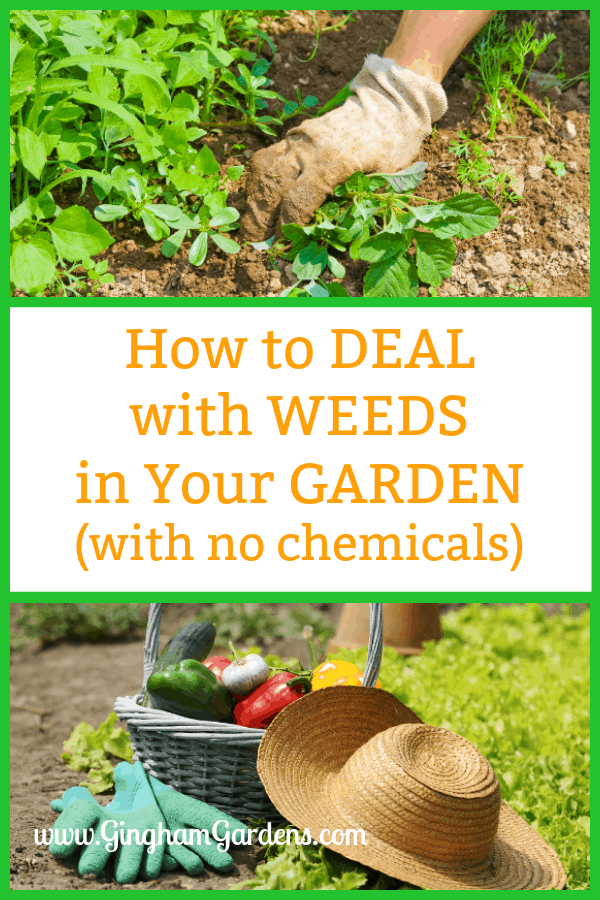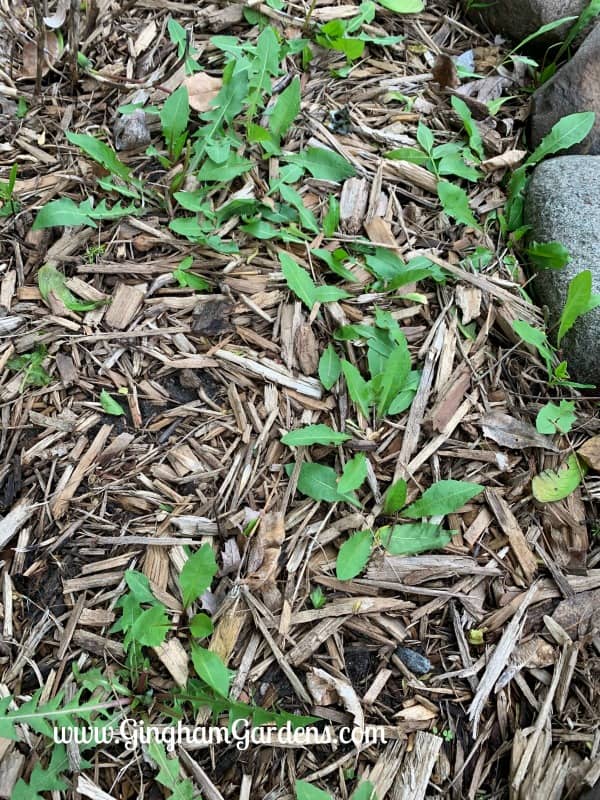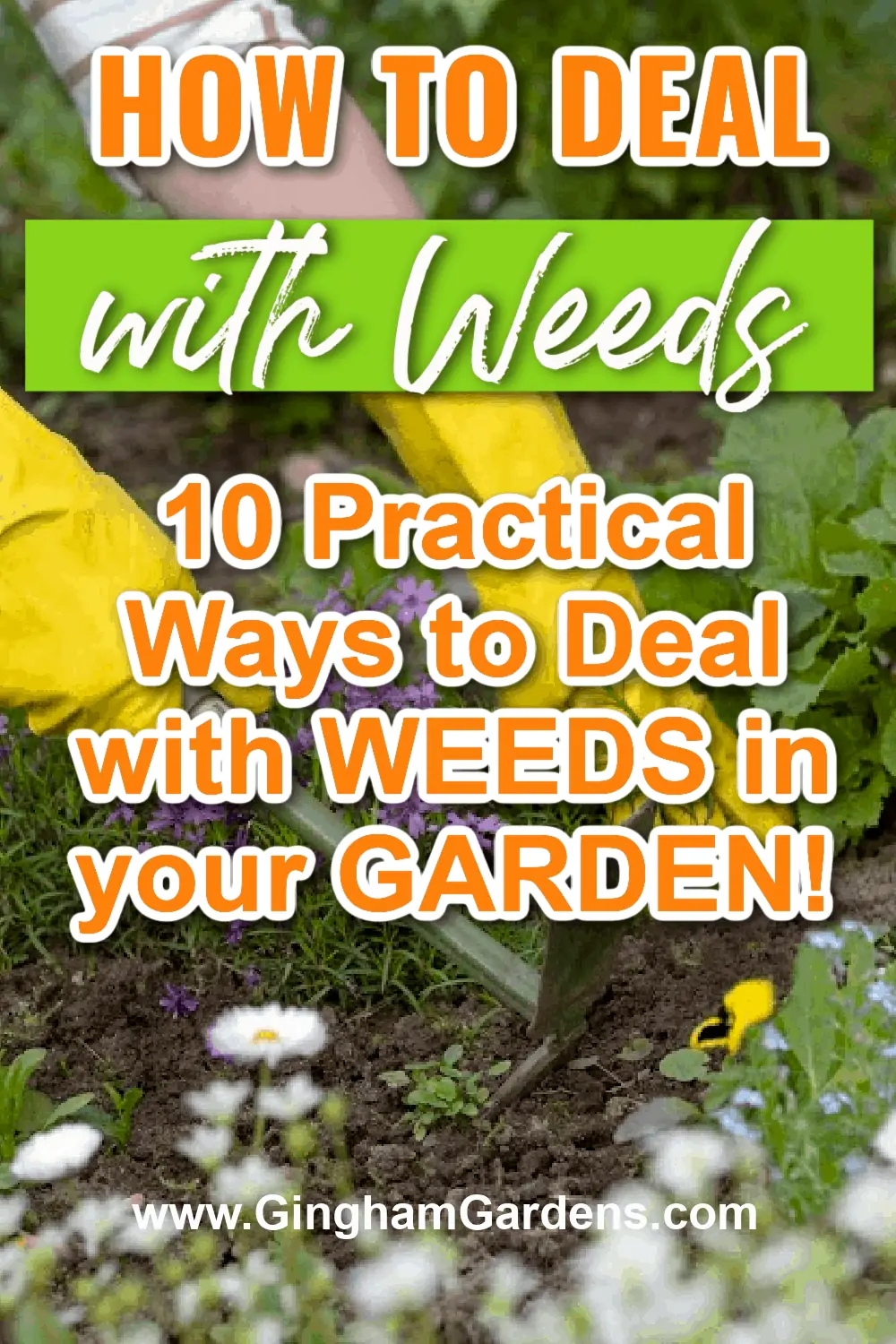How to Deal With Weeds in Your Garden
The number one question I see on gardening forums and Facebook gardening groups is, “how do I get rid of weeds in my garden,” or “what is the recipe for the homemade, organic weed killer.” My first instinct is to reply, “just pull the weeds.” I realize not everyone is crazy like me and enjoys pulling weeds. And, if I don’t take certain measures with all my gardening beds, I will be overrun with weeds. Today I’m sharing what works and what doesn’t work when it comes to dealing with garden weeds, along with tips on weed prevention.
This post contains affiliate links. If you click on
one of the links and make a purchase,
I may receive a small commission at no additional cost to you.
See full disclosure here.
Do Homemade Weed Killer Sprays Really Work?
There are so many “homemade” weed killer recipes just on Pinterest alone. Most of them start with a base of white vinegar and add all sorts of other things like lemon juice, Dawn dishwashing detergent, salt, borax, bleach, boiling water, etc., etc. Many of these recipes tack “natural” or “organic” to the title and people wanting instant results flock to them. My favorite (said in jest) is “an alternative to chemical weed killers.” Humm, vinegar, Borax, bleach, Dawn dishsoap are chemicals and there’s nothing organic or natural about them.
I hate to be the bearer of bad news, but they don’t work! Sure if you mix up one of these concoctions and spray weeds with it, the weeds will wither and turn brown, and there will even be pictures of the proof. But, are the weeds dead or gone for good? Chances are in a week or two, that weed will be right back at it, growing and annoying you. There is a horticultural vinegar that is touted as safe, but it’s 20% acetic acid and it can burn skin if it comes in contact with it. Ouch! No thank you! The base of a healthy garden is the soil. Who really knows what these so-called safe weed killers do to the soil? I’m not a scientist by any stretch of the imagination, but I suspect these weed remedies will trash your garden soil.
When using some of these weed killing mixtures, yes, the weeds will look dead, but it is not a systemic weed killer, meaning it doesn’t travel through the plant to get to the root. Take dandelions for instance, they have a very long tap root and they store energy in that root so that they can regrow if the plant is damaged. Homemade weed killers simply kill what they come in contact with. So again, it might look like it’s dead, but it will be back in a week or two. Plus, would you rather have a green weed, or a brown one? Don’t the dead weeds still have to be pulled?
I recently read this article. When you’ve finished up here, pop over and read it. It’s sort of a comical take on homemade weed killers.
Are Commercial Weed Killers Safe?
That’s for you to decide. We’ve all heard that RoundUp (a/ka glyphosate) is bad and has the potential to give you a bad disease. I think there is a place for Roundup, just not in our food supply. I’m also not sure it should be so readily available to people who want a quick fix to their weed problem and tend to overuse the stuff. If you decide you need to use Roundup, just use it as a last resort on weeds that can’t be dug out or invasive species.
Here’s a Pin to Save to one of your Gardening Boards
on Pinterest for future reference.
There are more pins at the bottom of the post.
How to Prevent Weeds in Gardens
If you can get weed prevention down, that is half the battle. No really, it’s more like 75% of the battle of weed control. Weed prevention is one of the easiest ways of controlling weeds.
As early spring arrives, there are millions of weed seeds in your gardens just waiting to germinate. The more you cultivate the soil, the more seeds you’re bringing to the surface and the more you’re giving them a chance to germinate. Now that’s depressing news, isn’t it?
Did you know there are different types of weeds? There are annual weeds (like crabgrass, lamb’s quarters, purslane and chickweed to name a few) and there are perennial weeds (like dandelions and quack grass). There are different shapes of weeds, like broadleaf weeds and grassy weeds. For instance, a dandelion is a broadleaf, perennial weed and crabgrass is an annual, grassy weed.
In my garden, Canada thistle wins the award for most pesky weeds. It has such long, underground stems or tap roots that it’s nearly impossible to get it all and then they haunt me for the entire growing season.
Here are some tips for preventing weeds in your gardens:
If you’ve read any of my other posts, you’ll know that I’m a huge fan of mulching. Always use a good, shredded wood mulch, not wood chips. Shredded mulch is much more dense than wood chips and works better and it greatly reduces the number of weeds in a garden.
Once I get a garden bed cleaned up in the spring and all the plants rearranged like I want, I will put down 3-4 inches of mulch. Again, a good shredded wood mulch is best to reduce sunlight to new weeds and choke them out. If the bed is new, I will also lay down thick layers of newspaper or cardboard around the plants before I mulch. My garden beds that are mulched always have fewer weeds.
What About Using Preen As Weed Prevention?
If I’m working in a garden that was left unattended, once I get the bed cleaned out, I will use Preen. The use of Preen is controversial for some, because it can be dangerous to aquatic life. I definitely would not use it, if there was a chance it would run off into a body of water. I’ve also read that some say it will kill earthworms. I have not seen that to be the case in my gardens- the earthworms are alive and happy.
Just a note on Preen – it is a pre-emergent herbicide, so it will not kill existing weeds. Preen only keeps new weed seeds from germinating. Please note that not only will it prevent weed seeds from germinating, but it will also prevent any seeds you have planted from germinating. The same goes with flowers that reseed. I prefer to keep my vegetable garden beds as organic as possible, so I do not use any kind of herbicide in them. The most effective way to use Preen is to sprinkle it over the soil surface in your gardens.
Don’t Use Landscape Fabric as a Weed Barrier in Flower Beds
Why? Because it does not work! And, you really don’t want it in a flower garden where you will be moving plants around and adding more plants. Plus, once dirt, debris and leaves accumulate on the top of the landscape fabric, weeds will grow on top of it. If you’ve ever tried to weed an area that has landscape fabric, you’ll know what I mean when I say it’s a complete nightmare. The roots of weeds grow into the landscape fabric and they are impossible to pull.
If you’re thinking about using it in an area where you’re never going to plant or move plants, go ahead, but just know that it will never stop weeds from growing. I do use landscape fabric for walking paths and places where I’m never going to plant, but knowing full well I will need to do some weeding now and then.
If you aren’t convinced not to use weed cloth in your flower gardens, pop over and read this post, and I’ll bet you’ll change your mind.
How To Keep Weeds Out of Vegetable Gardens
After all your veggie plants are in and direct sown seeds are up a couple of inches, it’s time to add some mulch to the rows or in between the plants. I like to use grass clippings (use only clippings from untreated grass) and leaf clippings. If the grass clippings are fresh, keep them a few inches from your plants, because they can heat up while drying out and can potentially burn your new vegetable plants. As the grass and leaf clippings dry, they will form a mat and this mat will form a barrier to help keep weeds down. The clippings will also help fortify the soil as they break down. You will still have to pull some weeds by hand, but that will be minimal especially if you stay on top of it and don’t let the weeds get out of hand.
If you have a vegetable garden that is cut into the ground and not a raised bed, be sure to add landscape edging around your entire garden. That will go a long way to keep grass and weeds from infiltrating your gardening space.
For walking paths, or between my raised vegetable beds, I use cardboard, newspapers or landscape fabric underneath a thick layer of mulch or pea gravel.
The Best Tools for Weeding
In addition to the shovel I mentioned above, this weeder, cultivator thingy has been a huge help. In some of my heavy duty garden makeovers, I’ve used it to break through root masses and rocky soil. Plus, it’s just an awesome multi purpose gardening tool and I use it just about every time I’m in the gardens.
I just purchased a stand-up weeder that was recommended by some other gardeners. There’s a learning curve to using it, but I’ve just about got it down and it’s going to work great. I’m hoping it will save my back.
#1 Way to Remove Weeds from Driveways and Sidewalks
We discovered this amazing gadget for removing weeds from our paved driveway, sidewalks and patio and it’s been amazing! We wish we would have tried it sooner. So what is it you ask… It’s a simple, inexpensive weed torch. Just go check it out when you’ve finished up here.
A Few More Tips on How to Deal With Weeds In Your Garden
Unfortunately, we’re always going to have weeds, it’s just a part of gardening. To help deal with them, here are a few more practical tips:
- The best time to weed is after a rain shower when the ground is soft and it’s the easiest to get all the weed roots.
- Stay on top of weeding! Once weeds produce seed heads, your battle against weeds will greatly intensify.
- Spend 10-15 minutes every day to make a pass through your gardens and weed. Use it as a time to unwind.
- If you have a weed pit to contend with, don’t just leave it. The weeds will go to seed and you will have double the problem. If you can’t pull weeds, at least use a weed whacker to chop them down.
- Be okay with imperfect. A few weeds here and there aren’t going to hurt anything. (This is for me!)
- Strictly personal preference here, but I do not throw weeds in the compost pile.
- You might hear packing plants in tight will help to avoid weeds. This isn’t my style of gardening, but if it’s yours go ahead and pack those plants in. Just be aware that some perennials, like Tall Garden Phlox and Bee Balm, need air to combat fungal diseases.
Do you have any tips for dealing with weeds in your gardens that I didn’t cover? If so, please leave a comment and let me know. Also, if you have a question, feel free to ask in the comments section.
Thanks so much for stopping by Gingham Gardens today! Be sure to stop back soon.
Happy Gardening,
Joanna
p.s. Follow Gingham Gardens on Pinterest for lots of great gardening ideas and tons of gardener’s eye candy.
p.p.s. You can pin these pictures by hovering in the upper left-hand corner. Pin away!
Pins to Share:






